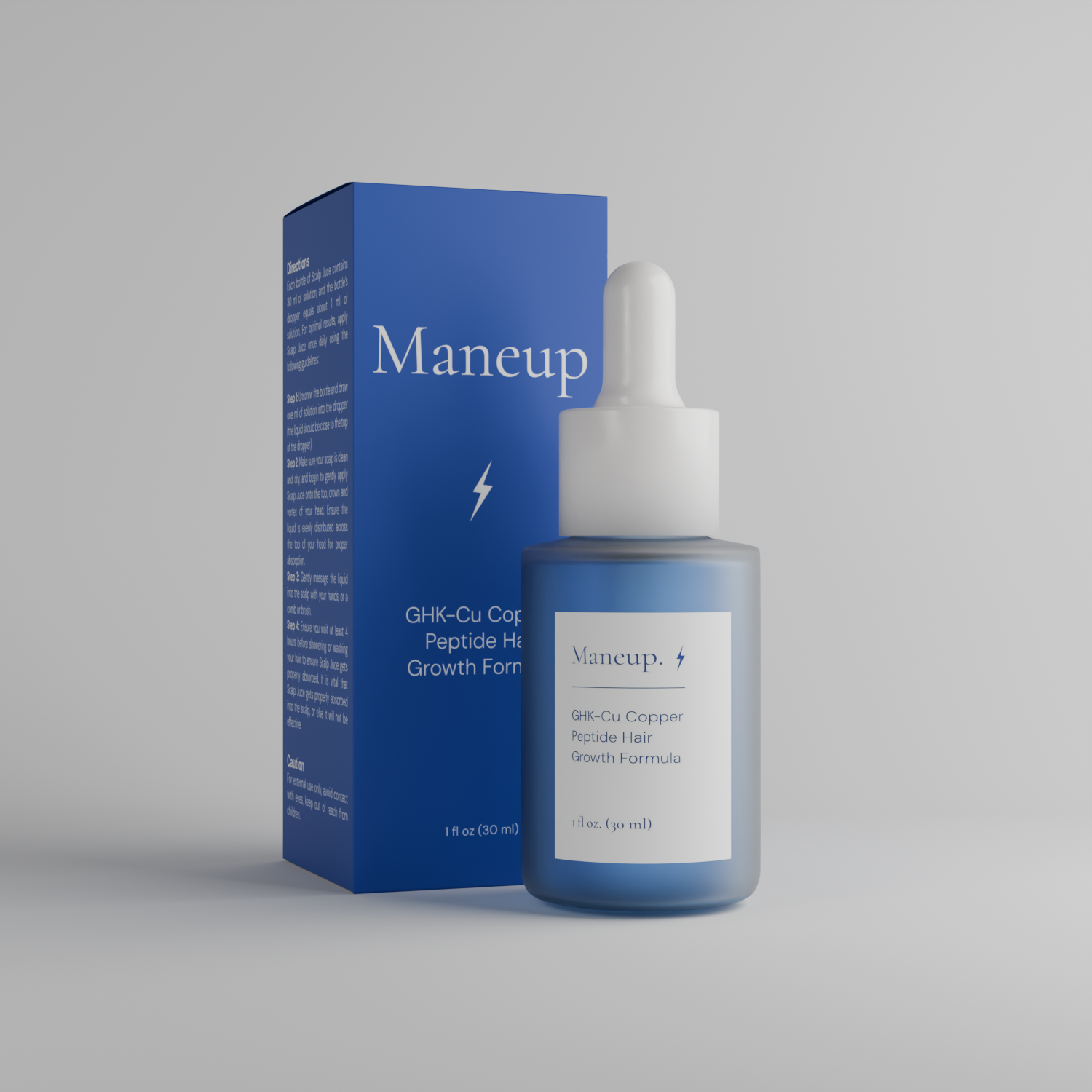Last updated: April 21st, 2025
Why Peptides Are The Next Big Thing In Hair Loss Treatment
Words by
Beowulf Urban

Share



Published on: May 16th, 2024
Featured Product
15% Off

Hair Restoration Serum | Advanced GHK-Cu Copper Peptide Formula
Use Code Blog15 For 15% Off
What are peptides?
Peptides are crucial in various physiological processes and serve as fundamental components in biochemical activities. They consist of short chains of 2 to 50 amino acids, formed through condensation reactions. {1} Peptides are classified based on the number of amino acid residues, with oligopeptides containing 10 to 20 residues and polypeptides having more than 20. Each amino acid in a peptide chain, referred to as a "residue," contributes to the chain's structure after a dehydration reaction. {1}
Why are they the next big thing in hair loss treatment?
Unlike traditional treatments that impose external forces on the body—often with side effects—peptides like GHK-Cu work with your body’s own biology, not against it. Rather than forcing hormonal changes or artificially dilating blood vessels, peptides act as biological messengers. They signal the body to upregulate specific regenerative processes that are already built into our physiology but may have slowed due to age, stress, or inflammation. In the case of hair loss, GHK-Cu doesn’t mask the problem—it helps solve it by activating pathways related to blood flow, collagen synthesis, inflammation resolution, and cellular repair. In this way, peptides are less like drugs and more like code—precision instructions that unlock your body’s innate ability to repair, regenerate, and thrive. This biologically harmonious approach is why many believe peptides are the future of hair restoration.
GHK-Cu And Hair Loss
The role of GHK-Cu in human skin and hair is multifaceted, providing numerous benefits in the overall health and longevity of skin and hair. Minoxidil and Finasteride dominate the hair loss market, however due to their downfalls and side effects, GHK-Cu has emerged as a viable solution which many people have begun experimenting with in the treatment of hair loss.
The mechanism of action with GHK-Cu is not unlike Minoxidil, however when compared, GHK-Cu has some obvious advantages as detailed in this study which states "copper peptides are a powerful hair growth promoter with minimal side effects when compared to finasteride and minoxidil." {2}
GHK-Cu does an excellent job at promoting blood flow on the scalp, just like Minoxidil. In particular, multiple studies show GHK-Cu promotes angiogenesis, actually building new blood vessels, and increasing blood flow in existing blood vessels, something that Minoxidil cannot do. {2}
It also drastically reduces fibrinogen, which heavily influences the flow of blood through the microcirculation. GHK's ability to suppress Interleukin-6, a regulator of fibrinogen production, suggests its potential in reducing fibrinogen levels and mitigating CVD risk. Additionally, GHK downregulates the gene responsible for the beta chain of fibrinogen, further inhibiting fibrinogen synthesis. {3}
The Role of Chronic Inflammation
GHK-Cu possesses strong anti inflammatory and anti oxidant properties. Since we know that chronic inflammation can be a major cause and accelerant of hair loss, specifically alopecia areota, this is a biological factor that goes completely untreated with Minoxidil. {4}
Animal experiments demonstrate that treatment with GHK leads to increased levels of antioxidant enzymes and possesses potent antioxidant and anti-inflammatory properties. GHK effectively neutralizes harmful free radical by-products of lipid peroxidation, such as 4-hydroxynoneal, acrolein, malondialdehyde, and glyoxal, thereby shielding skin keratinocytes from UV radiation damage. Notably, GHK significantly inhibits the Cu(2+)-dependent oxidation of low-density lipoproteins (LDL), offering superior protection compared to the widely used antioxidant superoxide dismutase (SOD1). Additionally, GHK binds to and prevents the damaging effects of lipid peroxidation by-products, including acrolein and 4-hydroxynonenal. {5}
Moreover, GHK in the presence of copper (GHK:Cu(2+)) markedly reduces iron release from ferritin by 87%. Ferritin, found in blood plasma, can store significant amounts of iron, which serves as a catalyst for lipid peroxidation—a process that generates harmful free radicals, causing damage to DNA, proteins, and cell membranes. Dysregulation of iron metabolism contributes to various pathological conditions, including brain damage and neuron death in neurological disorders. When iron is released from ferritin, it forms a complex and initiates lipid oxidation chain reactions, further exacerbating cellular damage. {5}
The Role of Cellular Dysfunction
We know that cellular disfunction in the form of cellular senescence is a huge underlying problem when it comes to hair loss. Healthy cells being stuck in "cell cycle arrest" which leads to a decline in their regenerative potential and tissue function. Furthermore it can lead to even more chronic inflammation and oxidative stress. {6}
Early research suggests that GHK may serve as an early signal for skin repair, with its amino acid sequence present in type I collagen. Experiments indicate that GHK stimulates collagen synthesis, glycosaminoglycans production, and modulates the activity of enzymes involved in protein breakdown and their inhibitors, thus promoting skin regeneration. {3}
Moreover, GHK exhibits positive effects on skin fibroblasts, crucial cells in skin regeneration, by increasing cell viability, growth factor production, and collagen synthesis when combined with LED irradiation. GHK-Cu specifically stimulates epidermal basal cells, enhancing their stemness and promoting skin renewal. These findings suggest GHK's potential in supporting skin health and appearance by promoting repair mechanisms and enhancing cellular functions critical for regeneration. {2}
The Role of Oxidative Stress & Hypoxia
Oxidative stress, stemming from an imbalance between free radicals and antioxidants, can trigger hair loss by harming the scalp and hair. Free radicals, unstable molecules, can wreak havoc on cellular components like membranes, proteins, lipids, and DNA. Consequently, oxidative stress can hinder hair growth by damaging the scalp, weakening the anchoring force of hair strands within follicles, and ultimately leading to hair loss. {7}
GHK-Cu plays a role in reducing oxidative damage by regulating iron levels. Iron complexes in damaged tissues hinder wound healing by promoting lipid peroxidation and microbial infections. Research shows that GHK-Cu inhibits lipid peroxidation when ferritin is the iron source. This is achieved by GHK-Cu binding to ferritin channels involved in iron release, thereby preventing the release of Fe(II). Consequently, GHK-Cu acts as an antioxidant in wounds by inhibiting ferritin iron release, which helps prevent inflammation and microbial infections. {7} {2}
Hypoxia is also a major concern for hair and hair loss, Hypoxia is a state in which oxygen is not available in sufficient amounts at the tissue level to maintain adequate homeostasis; this can result from inadequate oxygen delivery to the tissues either due to low blood supply or low oxygen content in the blood (hypoxemia). {8}
GHK-Cu combats hypoxia in the scalp by not only promoting blood flow, but opening up the hair follicle through cellular regeneration and increased blood flow, in turn allowing for higher nutrient partitioning and increased oxygen absorption. {2} {3}
Of course everyone knows that DHT plays a huge role in hair loss and is often believed to be the "only" contributing factor to hair loss. While this is a very one dimensional view of the hair loss equation, it still plays a massive role. GHK-Cu users will still need to get DHT under control, however by increasing blood flow on the scalp, the hair follicles sensitivity to DHT is diminished.
Using GHK-Cu to combat hair loss may be a more effective solution than finasteride and or minoxidil, particularly in the realm of hair regrowth. While more controlled human studies are needed, the clinical literature proves that it may be a better option that Minoxidil both in hair loss prevention and hair regrowth. Additionally, the lack of side effects make it an attractive alternative to both Finasteride and Minoxidil.
Frequently Asked Questions About Copper Peptides for Hair Loss
How long does it take for copper peptides to work on hair?
Visible improvements usually occur between 3–6 months with consistent use. Reduced shedding and healthier scalp conditions often appear within the first 2–4 weeks, followed by new hair growth around month 3.
Is copper peptides better than Minoxidil?
Copper peptides don’t force a single mechanism - they support multiple root causes of hair loss. They also don’t cause “shock loss” or hormonal side effects, and they benefit the scalp too. For many, GHK-Cu is a gentler and more comprehensive alternative.
Are topical copper peptides safe?
Yes. GHK-Cu is naturally produced in the body, non-toxic, and widely used in regenerative skincare. Side effects are rare and typically mild - such as temporary redness or tingling.
Can I use copper peptides with Minoxidil or Finasteride?
Yes, copper peptides are safe to use alongside other treatments. In fact, they may help reduce irritation caused by Minoxidil and support overall scalp health when used with Finasteride. They don’t interfere with hormonal treatments and may enhance results by working on different biological pathways.
Can women use copper peptides for hair growth?
Absolutely. GHK-Cu is non-hormonal, making it safe and effective for women experiencing thinning due to stress, postpartum shedding, or age-related hormonal changes.
Do copper peptides work for receding hairlines?
Yes. While results vary depending on how advanced the recession is, GHK-Cu has shown promise in stimulating dormant follicles and improving density in areas like the temples and hairline - especially when applied consistently in early stages.
What happens if I stop using copper peptides?
Since copper peptides work with your body’s natural processes, stopping won’t cause a dramatic “shock loss” like some medications. However, to maintain optimal results, long-term use is recommended - just like with any skincare or haircare routine.
Can copper peptides help with traction alopecia or hair loss from tight hairstyles?
Copper peptides may help repair damage from traction alopecia by reducing inflammation, improving circulation, and stimulating follicle regeneration. While they won’t reverse scarring, they can support regrowth in stressed but still active follicles when caught early.
Do copper peptides darken or change hair color?
Some users report a slight return of natural pigment in gray hairs, likely due to improved follicle function and antioxidant activity. However, copper peptides don’t chemically dye hair or alter color artificially - any darkening is subtle and biological in nature.
Is there a purging or adjustment phase when starting copper peptides?
Unlike Minoxidil, copper peptides rarely cause initial shedding or purging. Most users experience a smooth transition with gradual improvement in scalp health and hair density. Any minor tingling or redness is usually temporary and a sign of increased circulation.
Can copper peptides help with eyebrow or beard growth?
Yes. GHK-Cu supports hair follicle regeneration in all areas with active follicles, including eyebrows and facial hair. Many users apply it to patchy beards or thinning brows for improved density and growth over time.
Bibliography
1. National Center for Biotechnology Information. "Peptides: Chemistry, Structure and Biology." National Center for Biotechnology Information, U.S. National Library of Medicine, 4 Dec. 2019, https://www.ncbi.nlm.nih.gov/books/NBK562260/.
2. National Center for Biotechnology Information. "Contribution of the GHK-Cu Complex to Regulation of Stemness and Stem Cell Activity." National Center for Biotechnology Information, U.S. National Library of Medicine, 10 June 2020, https://www.ncbi.nlm.nih.gov/pmc/articles/PMC10643103/.
3. National Center for Biotechnology Information. "Premature hair loss in men and women: What can be done?" National Center for Biotechnology Information, U.S. National Library of Medicine, 17 July 2018, https://www.ncbi.nlm.nih.gov/pmc/articles/PMC6073405/.
4. National Institute of Arthritis and Musculoskeletal and Skin Diseases. "Alopecia Areata." National Institute of Arthritis and Musculoskeletal and Skin Diseases, U.S. Department of Health and Human Services, https://www.niams.nih.gov/health-topics/alopecia-areata.
5. National Center for Biotechnology Information. "Premature hair loss in men and women: What can be done?" National Center for Biotechnology Information, U.S. National Library of Medicine, 17 July 2018, https://www.ncbi.nlm.nih.gov/pmc/articles/PMC6073405/.
6. National Center for Biotechnology Information. "Hair Loss Disorders: The Mechanism of Inhibition by Natural Compounds." National Center for Biotechnology Information, U.S. National Library of Medicine, 29 July 2019, https://www.ncbi.nlm.nih.gov/pmc/articles/PMC6610675/.
7. National Center for Biotechnology Information. "Oxidative Stress in Ageing of Hair." National Center for Biotechnology Information, U.S. National Library of Medicine, 10 Jan. 2019, https://www.ncbi.nlm.nih.gov/pmc/articles/PMC6369642/#:~:text=Oxidative%20stress%2C%20the%20inability%20of,role%20in%20premature%20hair%20loss.
8. National Center for Biotechnology Information. "Hypoxia." National Center for Biotechnology Information, U.S. National Library of Medicine, 6 Mar. 2020, https://www.ncbi.nlm.nih.gov/books/NBK482316/#:~:text=Hypoxia%20is%20a%20state%20in,in%20the%20blood%20(hypoxemia).
Featured Product
15% Off

Hair Restoration Serum | Advanced GHK-Cu Copper Peptide Formula
Use Code Blog15 For 15% Off















